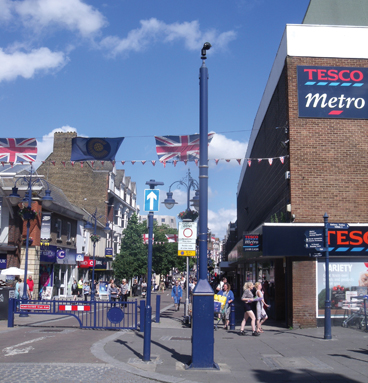Although local government has no need to provide public space CCTV as a service, and some towns and most notably Westminster has seen their on-street CCTV taken down and turned off, despite public sector austerity CCTV is still going and being renewed, on an ‘invest to save’ basis – in other words, some capital spending to centralise or rationalise the staffing of a control room (by far the largest expense) pays off over time. It not only may deliver a better crime prevention and investigation service, but can offer other benefits such as town centre Wi-Fi. Some of these trends, but not all, are on display from a cabinet meeting this month of Sittingbourne-based Swale District Council, in north Kent.
Swale Public Space CCTV Service has 52 field cameras and is monitored 24/7/365 by Medway Commercial Group from a control room in Strood, on behalf of the CCTV Partnership with fellow Kent councils Medway, Maidstone and Gravesham (pictured; Gravesend town centre). The council had the consultancy Global MSC Ltd – headed by Derek Maltby – provide technical CCTV advice.
What the review found is similar around the UK, as on-street CCTV was installed in the 1990s and early 2000s, whether with central government capital grants from the Conservatives and then Labour. A report told councillors that the system is ageing, and analogue, ‘with many cameras and equipment having reached or nearing the end of their life’. That matters financially because the images are transmitted over BT fibre cable, ‘which are expensive and inflexible’; and operationally because equipment is getting harder to source for spare parts, and especially at night and when cameras zoom in, the images are not of particularly good or evidential quality.
Swale has given notice that it’s pulling out of the CCTV Partnership by March 2020. It’s looking to replace its analogue system with digital, wireless CCTV. A CCTV Control Room is proposed within the Multi-Storey Car Park in Sittingbourne town centre, under Swale council’s direct management. Manning of the control room would no longer be 24-hours; monitoring ‘hours would be reduced to be in line with periods of higher crime/ASB [anti-social behaviour] and retail and night time economy premises working hours to prevent excessive costs’. While, then, Swale is looking to go more local, it does propose to include ‘capacity’, that is, spare room in the new control room in case another council wants to contract out its monitoring.
Swale proposes to offer Town Centre Wi-Fi within Sittingbourne, Sheerness and Faversham town centres, using the wireless CCTV infrastructure; which would have non-security benefits, such as online payments of car parking charges.
The report to cabinet sets out options – such as ‘do nothing’ (but Maidstone Council are also withdrawing from the contracted-out CCTV) and pulling the plug on public space CCTV altogether, as Westminster publicly did (but as the report suggests, Westminster may be an exception to the rule being in central London which ‘has copious amounts of private CCTV systems’). As for going out to tender to bring in a private or local government contractor, the report says that would ‘be unlikely to see operators with local knowledge of the area required for the most effective service. Delivery costs would vary and are unlikely to be significantly cheaper’.
As for money, the current cost to Swale of its public space CCTV is £277,000 a year; the new equipment and fitting out a new control room is put at £335,000. What’s proposed would save the council an estimated £70,000 a year; in other words, as the report tells councillors, ‘the cost of the proposals could be paid off within five years using an invest to save approach’. The revenue budget also includes a renewals fund, ‘to replace the field cameras after seven years when they reach the end of their useable life and their technology is outdated’. That means the council won’t be faced with a big capital spend for modernisation again, as it faces now.
To sum up, Swale is looking to make its CCTV monitoring as local as possible, on the principle that ‘CCTV is most effective when used as a package of tools to tackle a specified issue’. The end to 24-hour monitoring includes some lone working by control room staff, and staffing only when most crimes are reported. The report points to ‘advances in analytical software’ as a reason for not needing 24-hour human monitoring. The report proposes ‘a regular review of monitoring times and peak crime times to ensure that they are correctly aligned’; besides regular reviews of camera locations ‘to ensure that their ongoing deployment is justified considering the impact on individuals’ privacy’, as according to the Surveillance Camera Commissioner’s code of practice.










